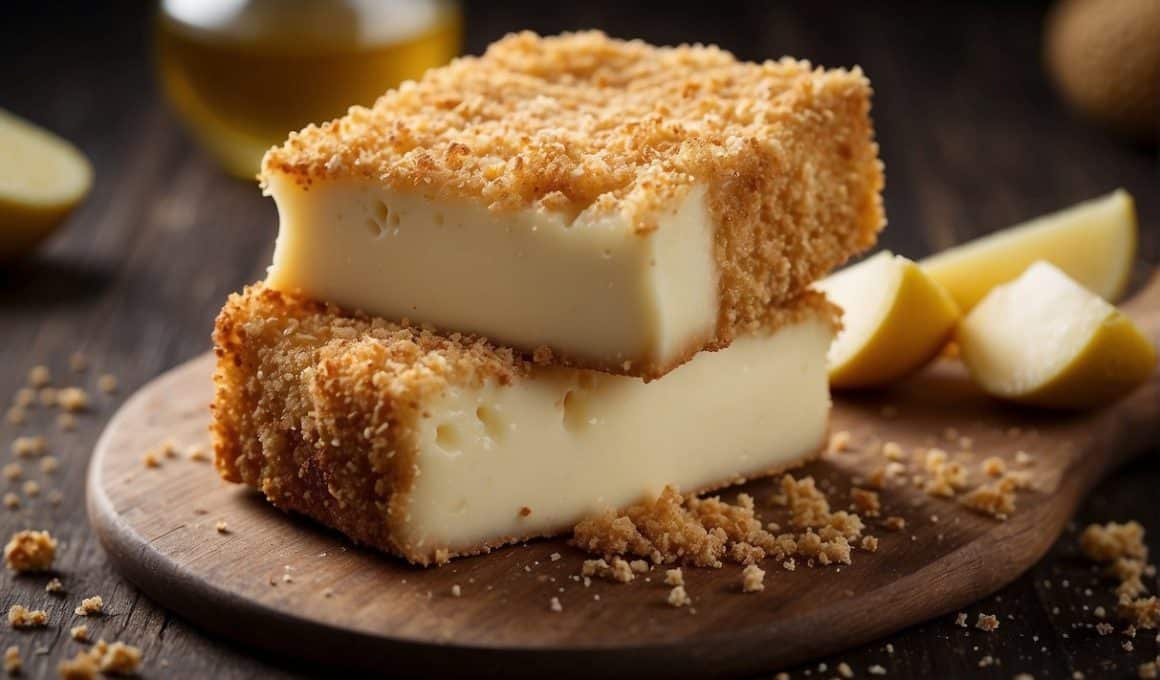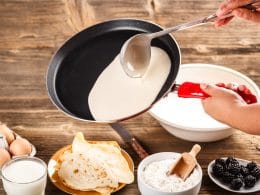Breaded brie is a culinary delight that transforms the creamy and smooth French cheese into a warm, oozy treat with a satisfyingly crispy exterior. This dish is often featured as an appetizer or a party starter, appealing to those who appreciate the rich texture and depth of flavor brie offers. The process involves coating the cheese in flour, egg, and breadcrumbs before frying or baking, creating a contrast between the crunchy breadcrumb coating and the melted brie inside.
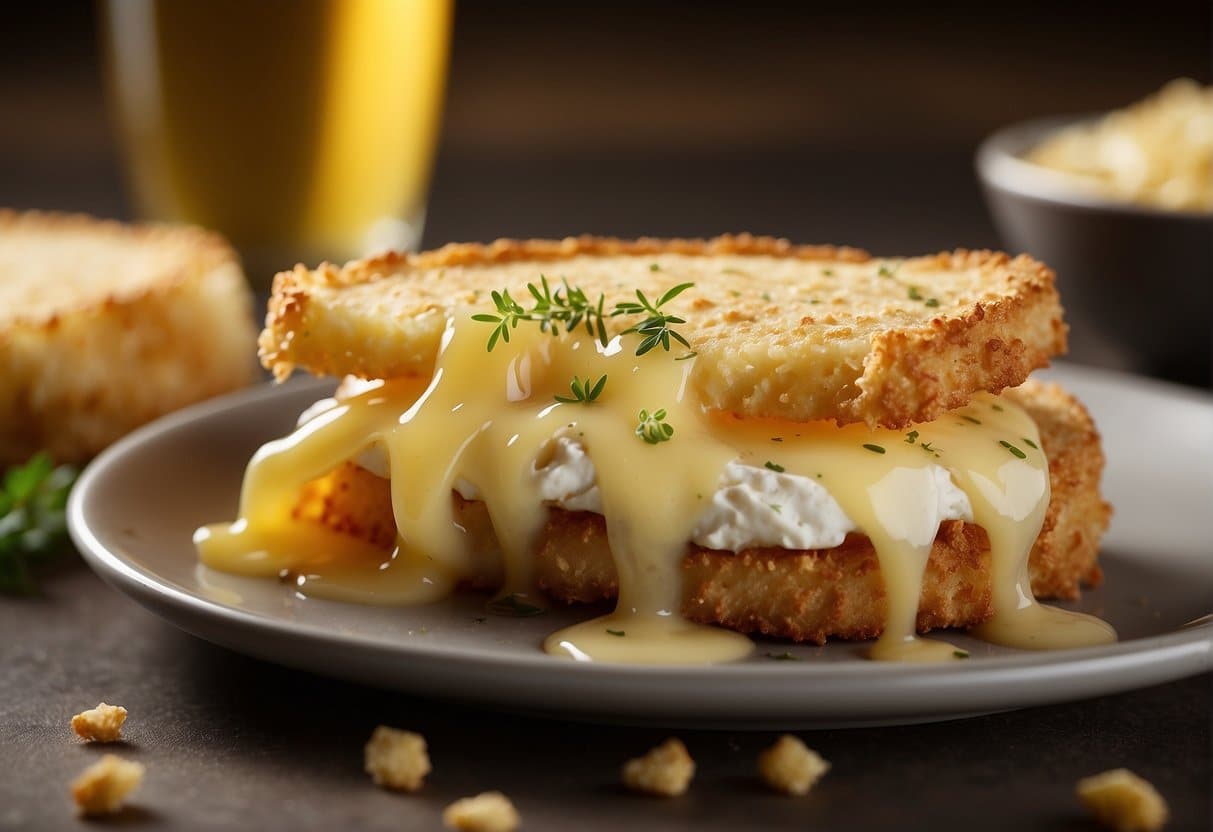
To create the perfect breaded brie, choosing quality ingredients is crucial. The brie should be ripe and gooey, but still firm enough to handle the breading process. While the classic breading elements include flour and breadcrumbs, experimenting with herbs and spices can elevate the flavor. Various serving suggestions exist depending on the occasion, from sweet chutneys and fruit jams to savory dips. Breaded brie can be a decadent addition to the dining experience, offering a touch of elegance and indulgence to any gathering.
Key Takeaways
- Breaded brie pairs a crispy exterior with a melted interior.
- Selecting quality cheese and ingredients enhances the dish.
- It can be served with sweet or savory accompaniments for versatility.
What Is Breaded Brie?
Breaded brie is a sumptuous appetizer that combines the creamy texture of brie cheese with a golden, crispy breadcrumb coating. Brie, originating from France, is a soft cow’s milk cheese named after the Brie region. When making breaded brie, I take care to preserve the mild and buttery flavor of the cheese while adding a satisfying textural contrast.
To prepare this dish, I usually cut the brie into wedges or small bite-sized pieces, which are then dipped in an egg wash and coated with breadcrumbs. I prefer to use panko for an extra crunch, although regular breadcrumbs also provide a satisfactory crust. Depending on the recipe, adding herbs and spices to the breadcrumb mix can enhance the flavor profile.
For cooking, breaded brie can be either fried or baked. While frying gives a more uniform golden brown color, baking is a wonderful alternative for those seeking a healthier option without sacrificing taste. Baking creates a delectable contrast between the brie’s softened interior and the sturdy breaded exterior.
Breaded brie is a versatile dish, transforming a simple block of cheese into a gourmet appetizer. It’s an easy appetizer for home cooks to master and a favorite for entertaining guests. Serving it alongside a fruit preserve or a light salad garnish can raise the presentation to the next level.
During gatherings, this party food appeals to both cheese aficionados and those seeking comfort food. It’s a delightful option for anyone looking to impress their guests with a touch of sophistication while still providing the familiar appeal of melted cheese.
Choosing the Right Ingredients
When I make breaded brie, I consider the quality of the brie, the type of breadcrumbs, and the frying oil essential for achieving that perfect melt-in-your-mouth texture and golden crust.
Selecting Quality Brie
Brie Cheese: For a luscious melt and full flavor, I always choose a high-quality French brie with a soft, creamy center. The rind should be white and velvety, and the brie should feel slightly springy to the touch. It’s crucial to let the brie come to room temperature before breading to ensure even cooking.
Types of Breadcrumbs
- Panko Breadcrumbs: They are my go-to for a crispy exterior. Panko breadcrumbs create a lighter and airier crust compared to traditional breadcrumbs, giving the brie an exquisite crunch.
- Traditional Breadcrumbs: If I’m after a finer texture, I opt for regular breadcrumbs which adhere nicely to the brie and yield a more uniform crust.
Best Oils for Frying
Olive Oil: A favorite choice due to its high smoke point and the subtle flavor it imparts. It’s perfect for achieving a golden-brown crust without overpowering the delicate taste of the brie.
Neutral Oils: Alternatively, oils like canola or vegetable oil work well as they don’t add any additional flavor to the breaded brie, letting the creamy cheese be the star.
Preparation Essentials
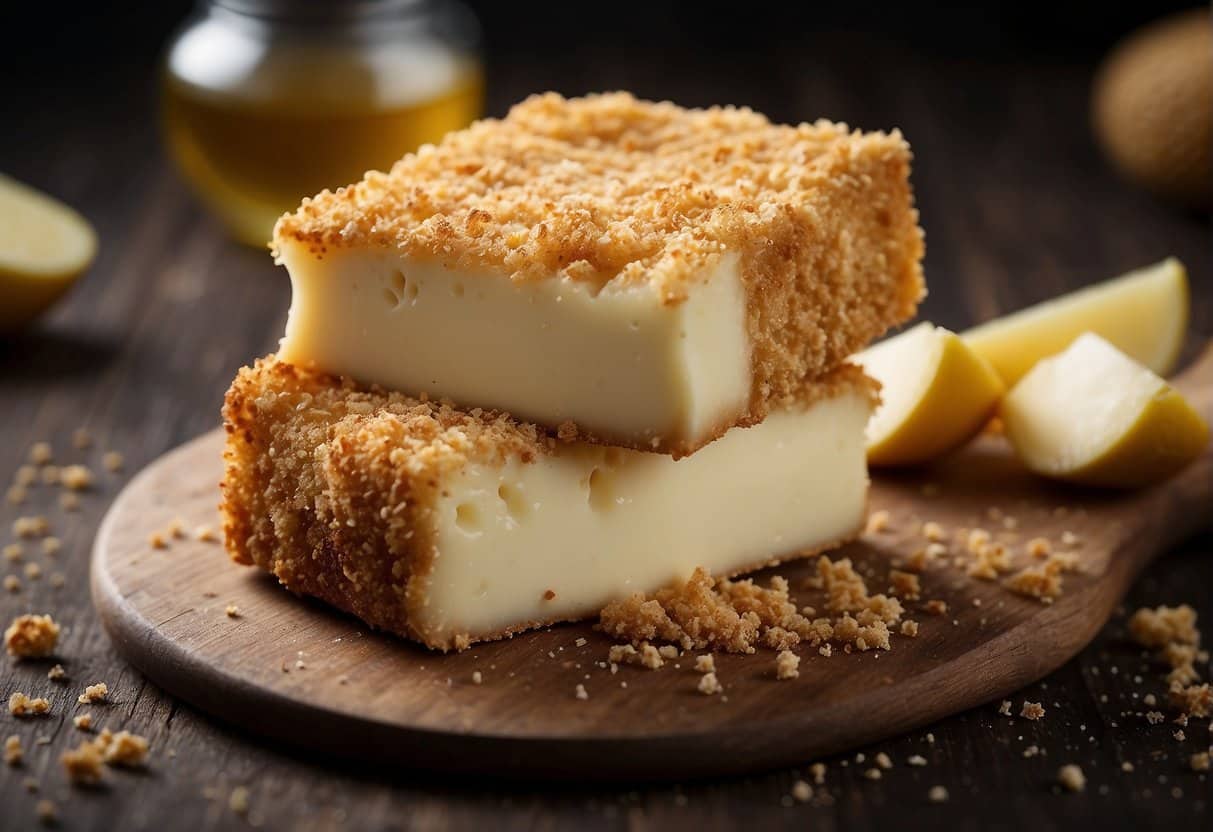
In crafting the perfect breaded brie, precision in preparation is as crucial as the quality of the brie itself. Here, I’ll walk you through the key steps: the initial prepping of the brie, the breading process, and how to set up your baking dish.
Prepping the Brie
I begin by choosing my brie carefully; a well-ripened wheel with a firm rind is essential. For this recipe, I’ll use one wheel of brie, which typically serves about 4 to 6 people. I make sure the brie is cold, which facilitates easier slicing and handling. I cut the brie into wedges, ensuring each piece includes some of the rind, which helps hold the cheese together during the cooking process.
Breading Procedure
The breading process starts with setting up a station with three shallow bowls. In the first bowl, I place about a cup of all-purpose flour. In the second bowl, I beat two large eggs until they are well mixed. The third bowl contains about a cup of breadcrumbs, which will provide the final coating. Each piece of brie is first dredged in flour, dipped into the egg wash, and then generously rolled in breadcrumbs, making sure each wedge is completely coated.
Setting Up the Baking Dish
For baking, I prefer to use a dish that is just a bit larger than my brie wheel. I line the dish with parchment paper to prevent the brie from sticking and making clean-up easier. Before I start breading the cheese, I’ll preheat my oven to 350°F (180°C), which is an ideal temperature to allow the brie to melt without burning the breadcrumbs. To ensure a golden crunch, I’ll lightly brush the top of the breaded brie with melted butter or a drizzle of oil before placing it in the oven. The preparation phase is crucial to ensuring that we have delicious, melty brie with a crisp, golden exterior.
Cooking Techniques
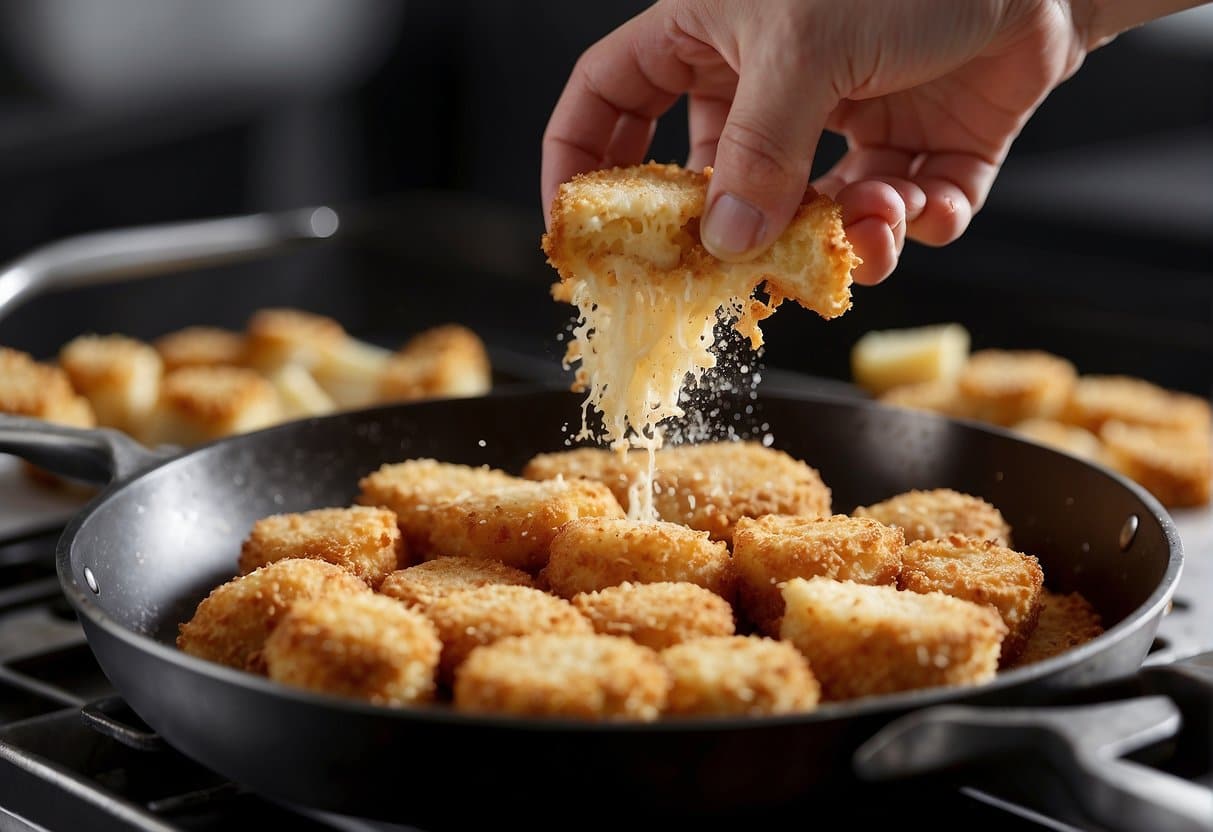
When I prepare breaded brie, I focus on achieving a deliciously crispy golden crust while ensuring the cheese is perfectly warmed through. The cooking time and technique are crucial for these results.
Oven Baking
For oven baking, I preheat my oven to a temperature that’s high enough to crisp the breading without melting the brie excessively. Usually, this is around 375°F (190°C). I place the breaded brie on a baking sheet lined with parchment paper to prevent sticking. The cook time in the oven is typically around 15 to 20 minutes. I keep an eye on the brie to make sure that the edges turn a delightful golden brown, indicating a crispy texture.
Total Oven Cooking Time: Approximately 15-20 minutes for a golden, crispy finish.
Alternative Cooking Methods
Aside from oven baking, there are a couple of alternative methods I use for a different finish or when I’m short on time:
- Pan-Frying: A skillet on medium heat with a bit of oil can quickly give the breaded brie a crispy outer layer. Each side takes about 2 minutes to cook; then I briefly sear the edges.
Total Pan-Frying Time: Roughly 6 minutes to crisp all sides.
- Microwave: While a microwave won’t achieve a crispy crust, it is a speedy alternative. If I only need to warm the brie without the crunch, I microwave it for around 30 seconds to 1 minute. However, this method is best paired with pre-toasting the breadcrumbs for a semblance of crispiness.
Total Microwave Time: 30 seconds to 1 minute to warm the brie.
Whether baked brie or a quick pan-fried option, I find that watching the cooking time closely is key to achieving that desired cheesy indulgence with a perfectly cooked crust.
Serving Suggestions
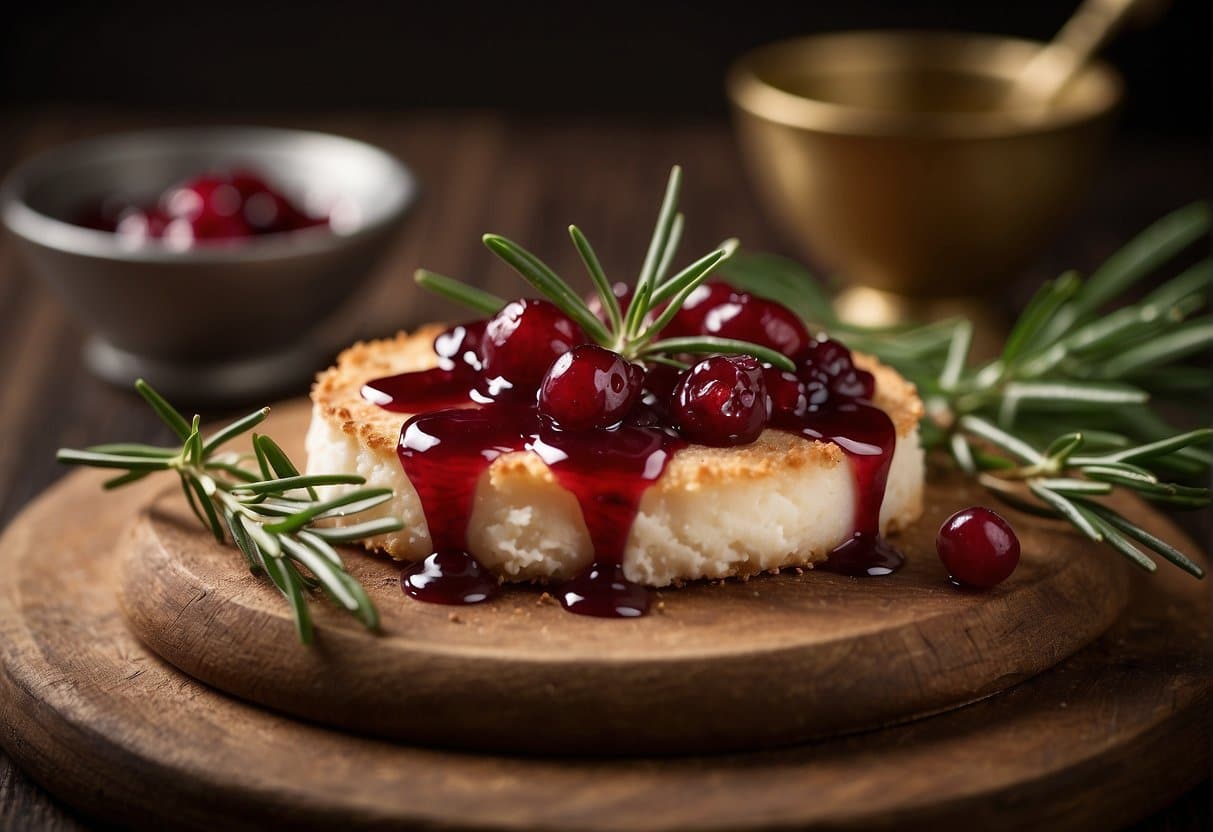
When I prepare breaded Brie as an appetizer, my focus is on complementing its creamy texture with a variety of flavors and playing up the presentation for a true visual feast.
Accompaniments
Fruits: I find that the sweetness of fruits like apple slices and pear create a pleasing contrast with the richness of the Brie. For a zestier palate, grapes or a dollop of fig jam can add a tangy twist.
I love sprinkling some chopped nuts such as pecans or almonds atop the Brie for a delightful crunch.
Crusty Breads: For scooping and dipping, I always prefer a golden and crusty bread like a baguette or toast points. These not only add texture but also a sturdy base for the softened cheese.
Crackers: A selection of crackers provides a quick and easy way for guests to enjoy their serving.
Toppings and Drizzles: To further elevate the dish, a variety of toppings can be used. I’ve found that a light drizzle of honey or maple syrup can enhance the natural flavors. For a savory note, garlic butter, caramelized onions, or a sprinkle of thyme and rosemary—both fresh thyme and fresh rosemary—are excellent choices.
Plating and Presentation
For presenting breaded Brie, I focus on creating a beautiful and accessible serving platter.
- Centerpiece: The Brie itself should be the centerpiece. I ensure it has a golden color from the breadcrumbs, contrasting nicely with the accompaniments.
- Arrangement: Around the Brie, apple slices and pear segments can be fanned out for an attractive display. Groups of grapes can be dotted around the edges for a pop of color.
- Garnishes: A sprinkling of cilantro or white pepper on the cheese can provide a pop of color and a hint of flavor that’s both appealing and aromatic.
- Sides: Small bowls of fig jam, jalapeño jelly, and honey can be placed around the platter for guests to use at their leisure.
- Nutrition: It’s good practice to include a small card detailing the nutrition information of the dish, especially for guests who may be monitoring their intake of specific ingredients.
For breaded Brie, the goal is to offer a balance of tastes and textures that compliment the creamy cheese—sweetness from fruit and syrups, crunch from nuts and crusty bread, and aromatic herbs for a fragrant touch. Each element of the presentation is chosen with care to ensure the final product is not only delicious but also visually appealing.
Nutritional Information
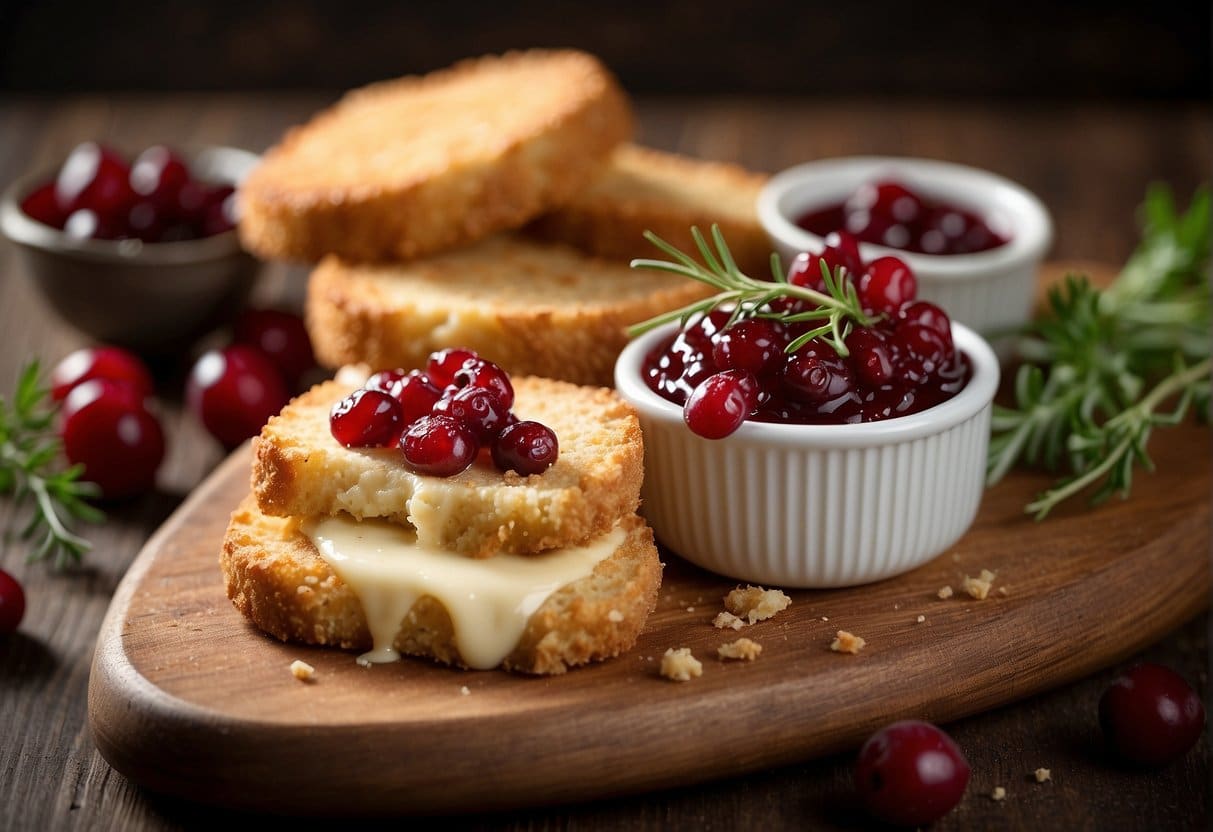
When I examine the nutritional aspects of breaded brie, I’m looking at a food item that’s indulgent and rich in several nutrients. Breaded brie, as I typically encounter it, involves a generous portion of brie cheese that’s coated in breadcrumbs and then baked or fried until the exterior is crispy. This method of preparation adds to the already high fat content of brie cheese, creating a dish that’s calorie-dense.
In terms of nutrition facts, a 1-ounce serving of brie cheese contributes to the following:
- Calories: 95 kcal
- Fat: 7.9g
- Saturated Fat: 5g
- Sodium: 178mg
- Carbohydrates: 0g
- Fiber: 0g
- Sugars: 0g
- Protein: 5.9g
- Calcium: 52.2mg
- Vitamin A: 168IU
- Vitamin B12: 0.468mcg
However, when brie is breaded, the nutritional profile changes, primarily because of the additional carbohydrates from the breadcrumbs and the oil absorbed during the frying process. For instance, as indicated by a restaurant nutrition guide, a small plate of breaded brie can contain:
- Calories: Approximately 500 kcal
- Carbohydrates: Around 58g
- Fat: 26g
- Protein: 10g
The quantities presented reflect typical servings, which can vary by restaurant or if I were to prepare it at home. When including breaded brie in my diet, it’s important for me to consider these nutrition details, especially if I’m monitoring my intake of fat, sodium, or overall calories.
Recipe Variations and Substitutions
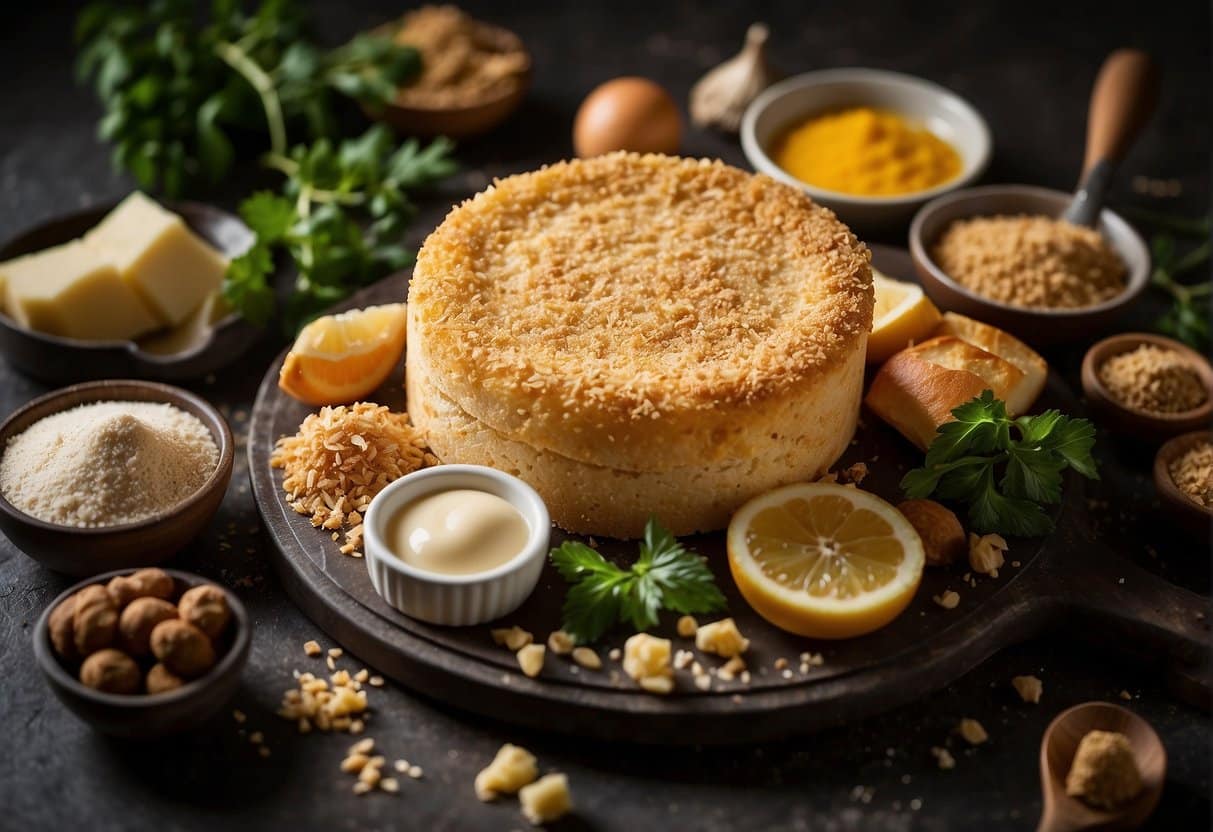
In my experience with breaded brie, adapting the recipe to suit different tastes and dietary requirements is simple. Whether you’re using alternative cheeses, seeking vegetarian and vegan options, or getting creative with the breading, the possibilities are endless.
Alternative Cheeses
If brie isn’t to your liking or you’re looking to try something new, Camembert is a fantastic substitute. With a similar creamy texture and rich flavor, Camembert can be breaded and cooked in the same way as brie. Additionally, for those who prefer a firmer texture, a well-aged Cheddar can provide a delightful contrast to the crisp coating, though melting characteristics differ.
Vegetarian and Vegan Options
Conventional brie and breadcrumbs may not be suitable for vegetarians and vegans. However, there are excellent plant-based cheeses on the market, and vegan brie alternatives are now readily available. To replace traditional breadcrumbs, consider using flour or a mix of almonds and panko breadcrumbs for a cruelty-free crispiness that doesn’t compromise on texture.
Creative Breading Ideas
When it comes to breading, plain flour and breadcrumbs are classic options, but I recommend exploring a bit further. For a richer, nuttier flavor, try using finely chopped almonds mixed with the breadcrumbs. Alternatively, for those looking to add an extra crunch, panko breadcrumbs offer a lighter yet crispier coating, perfect for encasing the soft cheese.
Presentation and Storage
In my experience, the visual appeal and the longevity of breaded brie are equally important. I focus on presenting it with a golden brown crust and ensure proper storage to maintain its quality. Below, I’ll guide you through the best practices for storing breaded brie and how to properly reheat it.
Proper Storage Methods
After serving breaded brie, any leftovers should be stored promptly to preserve their freshness. Here’s how I do it:
- Cool Down: Allow the brie to cool to room temperature. Avoid placing hot brie directly in the refrigerator as it can raise the internal temperature and affect other stored items.
- Wrap Properly: Use cling film or aluminum foil to wrap the brie tightly, minimizing exposure to air.
- Refrigerate:
- Place the wrapped brie in an airtight container.
- Store in the refrigerator at a consistent temperature to extend its shelf life.
Note: It’s crucial to not keep the breaded brie at room temperature for more than two hours after cooking, as bacteria can grow rapidly.
Reheating Instructions
When reheating breaded brie, I always aim to restore its delightful crispiness while ensuring the cheese is warm and molten inside. Here’s my method:
In the Oven:
- Preheat the oven to 350°F (175°C).
- Place the breaded brie on a baking sheet lined with parchment paper.
- Heat for about 10 minutes or until the brie is warmed through and the surface is golden brown again.
In the Microwave:
- Although not my preferred method due to the potential for a soggy crust, here’s how to do it:
- Place the breaded brie on a microwave-safe plate.
- Use the microwave’s reheat setting or heat on medium power for short intervals of 20-30 seconds, checking the texture between intervals.
Ensuring the breaded brie is heated evenly is key. The servings should be managed carefully, not to overheat, as this can lead to loss of texture and flavor.
Social Sharing and Engagement
When I craft a scrumptious breaded brie, social media provides fantastic platforms for showcasing my culinary creation and interacting with a community of food enthusiasts. Below, I detail my approach to sharing and engaging with an audience that appreciates delectable cheese recipes.
Sharing Your Creations
Facebook & Instagram: I use high-resolution images and step-by-step video content to grab the attention of fellow cheese lovers. I make sure the golden, crispy texture of my breaded brie is front and center in each photo. On Instagram, I add relevant hashtags like #BreadedBrie and #CheeseLovers to reach those with a taste for gourmet cheese dishes.
- Pinterest: My recipe pins include enticing pictures and a link back to my full breaded brie guide, making it easy for home cooks to find and save my instructions.
Engaging with Followers
Twitter: I engage directly by posing questions like, “What’s your favorite dipping sauce for breaded brie?” or by sharing quick tips that entice a response. I also retweet when someone tags me in their version of my breaded brie creation.
- Facebook & Instagram Stories: Polls and Q&A features on Stories allow me to discuss brie variants or cooking techniques. Video replies to comments show I value my followers’ engagement and foster a community atmosphere.
By integrating visuals with targeted social media tools, I reach a wider audience and foster rich interactions around my breaded brie recipes.
Tips for Cooking with Brie
When I’m preparing brie cheese, I aim for a melty, gooey center that delivers a luxurious taste with each bite. To achieve that coveted golden brown and crispy exterior, it’s important to manage the heat carefully. For instance, when I’m breading brie, I heat the oil on a low-medium setting to avoid burning the breadcrumbs while allowing the cheese to warm slowly. This ensures the brie becomes perfectly melted inside the coating.
Here are my go-to tips:
- Prep the Brie: Before starting, I make sure my brie is well-chilled; this keeps it from disintegrating during the cooking process.
- Cooking Method:
- Frying: I gently lay the cheese in oil and let it cook undisturbed for two minutes on each side. Then, I crisp the sides briefly.
- Baking: I place the brie on a baking sheet lined with parchment paper and bake until the center feels liquid when tested. This usually takes about 15 minutes at 375°F.
- Herbs and Flavorings: Fresh herbs like fresh thyme or fresh rosemary can be sprinkled atop the brie before cooking. Their aromatic oils are activated by heat, infusing the cheese with additional flavor.
- Handling the Cheese: Whether I’m flipping it in a pan or testing it for doneness in the oven, I handle brie with care to maintain its shape.
By following these tips, my bried cheese comes out impeccably—crispy on the outside with a warm, melted center that’s irresistible.
Additional Pairings and Garnishes
In my experience preparing and serving breaded brie, selecting the right pairings and garnishes is crucial. They not only complement the creaminess of the brie but also enhance its flavor profile, turning the dish into a gourmet experience. Let me walk you through some specific recommendations to make the most of your breaded brie.
Fruit Pairings
The key to pairing fruits with breaded brie is to balance sweetness with a touch of tanginess.
- Fresh Fruits: Adding slices of crisp apples or juicy pears can introduce a refreshing crunch that harmonizes with the soft texture of melted brie.
- Roasted Grapes: Roasting grapes until they burst brings out a concentrated sweetness that perfectly offsets the rich brie.
Herb Enhancements
Herbs impart an aromatic quality that can elevate breaded brie from simple to sublime.
- Rosemary and Thyme: Sprinkling finely chopped rosemary or thyme over your breaded brie before baking infuses it with an earthy essence.
- Cilantro: A little cilantro can add a bright, citrusy note, which is particularly delightful with a spicier brie coating.
Sweet and Savory Toppings
I find that a mix of sweet and savory elements can turn breaded brie into a true crowd-pleaser.
- Nuts and Syrups: A drizzle of maple syrup and a scattering of toasted almonds or pecans create a topping that’s both crunchy and seductively sweet.
- Jams and Onions: A spoonful of fig jam or a heap of caramelized onions provides a rich depth of flavor that’s irresistible.
These are my personal findings and suggestions for additions that truly complement breaded brie, catering to a range of tastes while keeping the integrity of the cheese’s delicate flavor.
Culinary Techniques and Skills
In this section, I’ll guide you through two essential components for creating the perfect breaded brie: achieving a delightful crispy exterior and ensuring the cheese melts just right to that gooey perfection.
Mastering the Crispy Exterior
To achieve a crisp and golden brown coating on the breaded brie, I start by selecting the right breadcrumbs. Panko breadcrumbs are my top choice as their larger flakes create an unbeatably crunchy texture that contrasts beautifully with the soft cheese inside. Here’s my process:
- Prep the Brie: I cut the brie into the desired shapes, ensuring not to slice them too thin to prevent the cheese from leaking out during cooking.
- Breadcrumb Mixture: I create a coating station with flour, beaten eggs, and panko breadcrumbs seasoned to taste.
- Coating the Brie: I coat each piece of brie first in flour, then egg, and finally in panko, pressing gently to adhere.
- Frying: In a pan, I heat oil to a medium-high temperature. I fry the brie until each side turns a delectable golden brown, usually two minutes per side.
Tip: Make sure to heat the oil to the correct temperature. Too hot, and the brie will burn; too cool, and it will absorb the oil, losing its crispiness.
Achieving the Perfect Melt
Melting brie to achieve that delightful stretch without it becoming overly runny is an art. Follow these steps for the best results:
- Oven Technique: For a wheel of brie that stays intact while becoming tantalizingly melted inside, I preheat my oven to 375 degrees. I then place the brie on parchment paper and let it warm until it feels soft and liquid when touched, about 10 to 15 minutes.
- Pan Frying: When pan-frying breaded brie, I carefully monitor the heat. It should be melted inside but still have structure so the cheese holds its shape when cut into. This again takes about two minutes per side on a low-medium heat as I found on Sprinkles and Sprouts.
The key is to maintain an even temperature and patience; checking the brie’s texture is important to get that perfect melt without a mess.
Food Safety and Handling
When handling breaded Brie, which is a type of cheese, it’s crucial to prioritize food safety from preparation through to storage. Initially, during prep time, I ensure that all my utensils are clean and that I’ve washed my hands thoroughly. This includes ensuring that items like the slotted spoon and any cutting boards are properly sanitized.
My storage method for breaded Brie involves keeping it chilled to prevent bacterial growth. Ideally, Brie should be kept at temperatures between 35°F (1.5°C) and 40°F (4.5°C) to maintain its freshness. It’s important to note that the rind of the Brie should also be considered during storage, as it is delicate and can affect the overall condition of the cheese if not handled properly. Below is a quick guide to handling and storage:
- Preparation: Clean hands and utensils; keep raw and cooked foods separate.
- Storage Temperature: Between 35°F and 40°F.
- Rind Care: Handle gently; protect from damage.
When it comes to reheating breaded Brie, I always follow the cooking instructions precisely. If I need to reheat it, I ensure that it reaches a temperature hot enough to kill any potential bacteria, generally above 165°F. In terms of tools like a slotted spoon, I use it specifically for tasks related to the Brie to avoid cross-contamination.
Throughout all these stages, I remain vigilant about food safety practices, understanding that proper handling, storage, and reheating are key to preventing foodborne illness.
Holiday and Special Occasion Recipes
Brie’s creamy texture and versatile flavor profile make it a favorite for festive gatherings. I’ve found that incorporating this cheese as an appetizer transforms any holiday or special occasion into an unforgettable event.
Brie as a Festive Appetizer
Christmas gatherings and holiday parties call for appetizers that provide a touch of elegance alongside rich flavor. Serving Baked Brie with Cranberry Sauce taps into the festive spirit with its vibrant color and tart sweetness complementing the brie’s creaminess. The combination is a surefire way to impress at a Christmas party. The warmth and richness of melted brie also make it a cozy and welcoming starter for the colder months, satisfying guests as they anticipate the main feast.
Celebration Serving Ideas
For party food at a special occasion, I often present brie creatively to enhance the visual appeal. Brie, when coated with breadcrumbs and lightly fried or baked to create a crispy exterior, reveals a seductively gooey centerpiece upon cutting. I follow tips for making Breaded Brie to ensure each piece is perfectly golden and ready for my serving platter. I scatter an assortment of crackers, slices of baguette, or even fresh fruit around the cheese to offer a variety of textures and flavors. My guests are invariably drawn to this centerpiece on the entertaining platter, enjoying the harmonious balance of crunchy exterior and molten interior with every bite.
Conclusion
In my exploration of breaded brie, I’ve found that the method you choose for preparing this decadent appetizer can vary, but the end goal is always a delicious combination of a crisp exterior with a warm, melting core. When I cook with brie, I prefer using a low-medium heat to prevent burning, and I make sure to cook each side for approximately two minutes, as suggested by Sprinkles and Sprouts. This technique ensures that the brie is perfectly golden without sacrificing its creamy texture.
Another key point I’ve learned is the importance of the accompaniments that go with breaded brie. Simple additions like a light salad or fruit compote can elevate the richness of the brie. Substitutions and variations can personalize the dish, but I always stick to one principle: simplicity is the ultimate sophistication.
Whether you’re in the mood for a classic version or something more unique like Baked Brie with maple syrup and thyme, the possibilities are endless. If you’re new to this, don’t be intimidated. Remember, brie is forgiving and when it’s enveloped in a warm, crispy coating, you’re in for a treat that’s both elegant and comforting.
Frequently Asked Questions
In my experience, these specific inquiries come up often when discussing breaded brie preparation. Here’s what I know.
What is the best way to prepare a breaded brie recipe at home?
I find that the key to preparing breaded brie at home is setting up a breading station with flour, eggs, and breadcrumbs. Gently coat the brie with flour, dip into beaten eggs, then cover with breadcrumbs prior to cooking.
How can I cook breaded brie in an air fryer for optimal crispiness?
To achieve optimal crispiness in an air fryer, preheat your air fryer to a medium-high temperature. Place the breaded brie in the basket and cook for about 8 minutes, turning halfway through the cooking time.
Which type of jam pairs well with breaded brie for a harmonious flavor?
A fruit jam with a hint of tartness, such as cranberry or raspberry, complements the creamy texture of breaded brie beautifully.
What are the necessary steps for baking breaded brie to achieve a perfect golden crust?
To bake breaded brie, preheat your oven to a medium-high temperature, place the breaded brie on a lined baking sheet, and bake until the crust is golden and the cheese is soft inside, typically about 15 minutes.
How can I make breaded brie bites for a bite-sized appetizer?
Cut the brie into small cubes, follow the standard breading procedure, and either bake or deep-fry until golden brown. These make for delectable, bite-sized appetizers.
Is it necessary to remove the rind from brie before breading and baking it?
No, it’s not necessary to remove the rind. The rind is edible and helps contain the melted cheese, but if preferred for texture, you may remove it.





